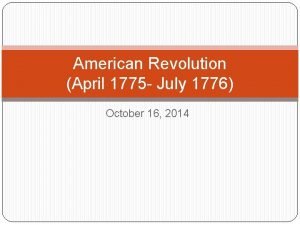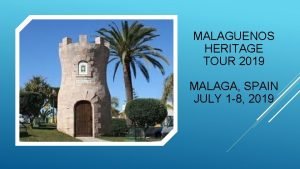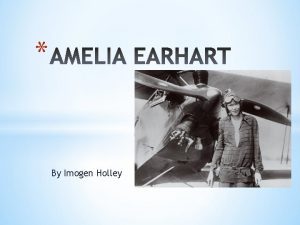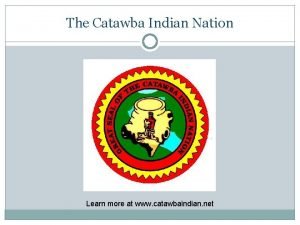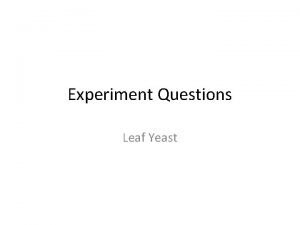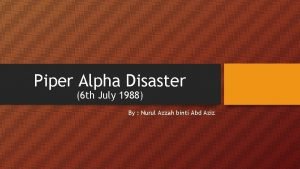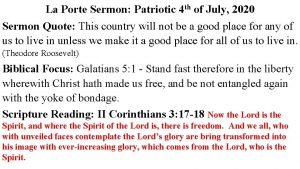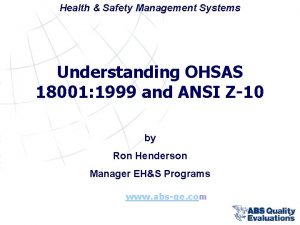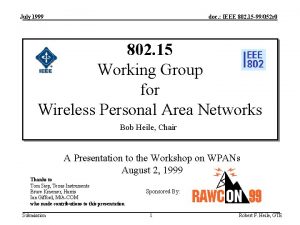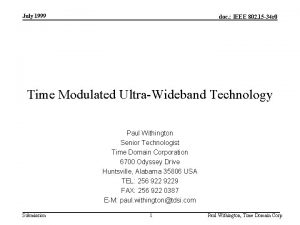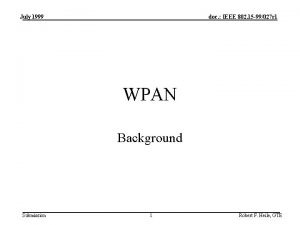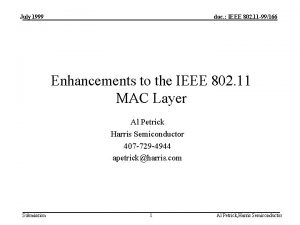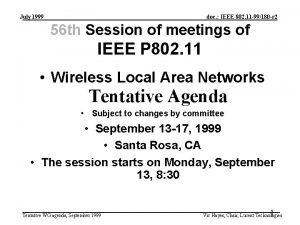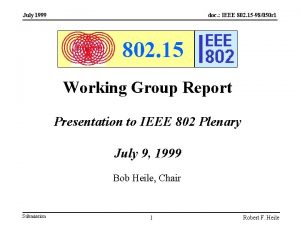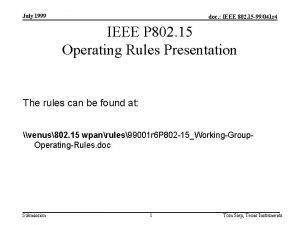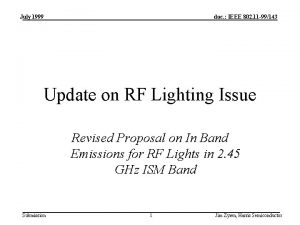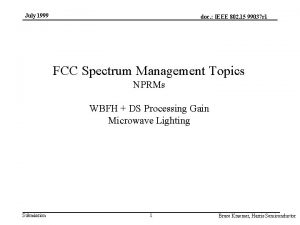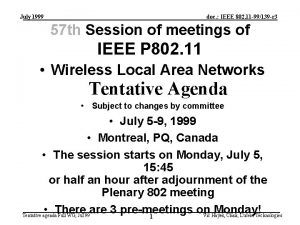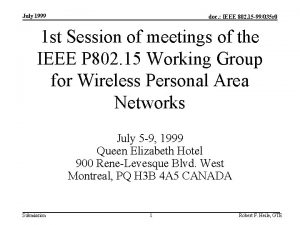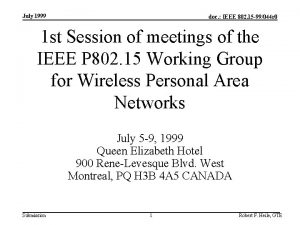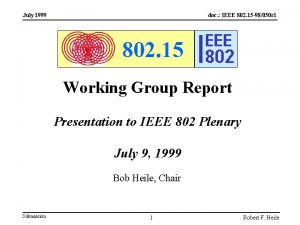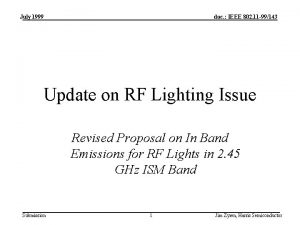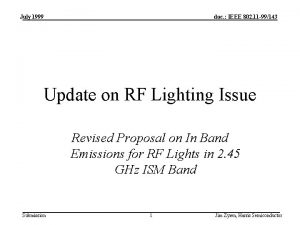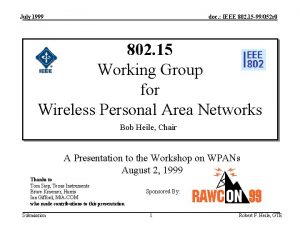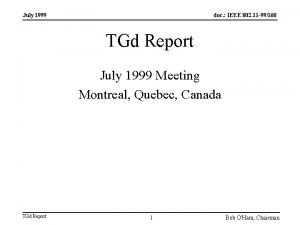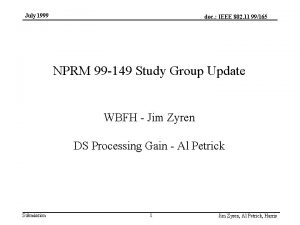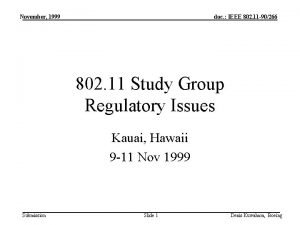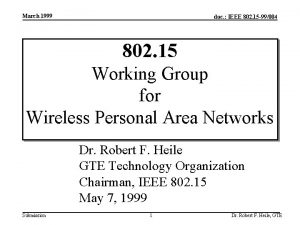July 1999 doc IEEE 802 15 99042 r














































- Slides: 46

July 1999 doc. : IEEE 802. 15 -99/042 r 4 IEEE P 802. 15 Wireless Personal Area Network Description of Proposed Structure for Draft MAC and PHY Standards Submission 1 Tom Siep, Texas Instruments

July 1999 doc. : IEEE 802. 15 -99/042 r 4 IEEE 802 Structure Submission 2 Tom Siep, Texas Instruments

July 1999 doc. : IEEE 802. 15 -99/042 r 4 The Project 802 Domain Submission 3 Tom Siep, Texas Instruments

July 1999 doc. : IEEE 802. 15 -99/042 r 4 Original Bluetooth to IEEE 802. 15 Submission 4 Tom Siep, Texas Instruments

July 1999 doc. : IEEE 802. 15 -99/042 r 4 New Understanding of Bluetooth/IEEE Correspondence Submission 5 Tom Siep, Texas Instruments

July 1999 doc. : IEEE 802. 15 -99/042 r 4 Taxonomy of an 802 Standard Submission 6 Tom Siep, Texas Instruments

July 1999 doc. : IEEE 802. 15 -99/042 r 4 Outline of Standard Main Text 1) 2) 3) 4) 5) 6) 7) 8) Submission Overview Normative References Definitions Abbreviations and Acronyms General Description Medium Access Control (MAC) Physical Layer (PHY) Layer Management 7 Tom Siep, Texas Instruments

July 1999 doc. : IEEE 802. 15 -99/042 r 4 Outline of Standard Appendix A. Protocol Implementation Conformance Statement (PICS) proforma B. Formal Description of MAC operation C. Formal Description of PHY operation D. MAC Management Information Base E. PHY Management Information Base F. Bibliography Submission 8 Tom Siep, Texas Instruments

July 1999 doc. : IEEE 802. 15 -99/042 r 4 Clause 1 • Overview – Scope – Purpose Submission 9 Tom Siep, Texas Instruments

July 1999 doc. : IEEE 802. 15 -99/042 r 4 Clause 2 • Normative References – Other documents (IEEE, ISO, ITU…) Submission 10 Tom Siep, Texas Instruments

July 1999 doc. : IEEE 802. 15 -99/042 r 4 Clause 3 • Definitions – Terms specific to this Standard Submission 11 Tom Siep, Texas Instruments

July 1999 doc. : IEEE 802. 15 -99/042 r 4 Clause 4 • Abbreviations and Acronyms Submission 12 Tom Siep, Texas Instruments

July 1999 doc. : IEEE 802. 15 -99/042 r 4 Clause 5 • General Description – Architecture – Components – Services Submission 13 Tom Siep, Texas Instruments

July 1999 doc. : IEEE 802. 15 -99/042 r 4 Clause 6 • Medium Access Control The part of the data link layer that supports topology-dependent functions and uses the services of the physical layer to provide service to the logical link control (LLC) sublayer. In ISO/IEC 8802, the combined set of functions in the DQDB Layer that support the MAC Sublayer service to the logical link control (LLC) sublayer . Submission 14 Tom Siep, Texas Instruments

July 1999 doc. : IEEE 802. 15 -99/042 r 4 Clause 6. 1 • MAC Service Definition (MAC_SAP) – Overview – Service Specification The unconfirmed connectionless-mode MAC service defined in ISO/IEC 10039, as an abstraction of the features common to a number of specific MAC services for Local Area Networks . Submission 15 Tom Siep, Texas Instruments

July 1999 doc. : IEEE 802. 15 -99/042 r 4 Clause 6. 2 • MAC Frame Formats – Conventions – General Frame Formats – Format of Individual Frame Types Submission 16 Tom Siep, Texas Instruments

July 1999 doc. : IEEE 802. 15 -99/042 r 4 MAC Frame Format Conventions 802. 11 Example • The sequence of octets in the fields of the MAC frame forms an octet stream at the MAC/PLCP sublayer boundary. The leftmost octet in each field of the MAC frame is passed across the MAC/PLCP boundary first. • Fields that are longer than a single octet are depicted with the least significant octet on the left. The least significant bit of each octet is defined as bit 0 for that octet and is the leftmost bit of the octet. Fields that are less than one octet in length are ordered with the least significant bit to the left. • MAC addresses are assigned as ordered sequences of bits. The Individual/Group bit is always transferred first and is the least significant bit of the first octet. • Values specified in decimal are coded in natural binary unless otherwise stated. • Reserved fields and subfields are set to 0 upon transmission and are ignored on reception. Submission 17 Tom Siep, Texas Instruments

July 1999 doc. : IEEE 802. 15 -99/042 r 4 MAC General Frame Formats 802. 11 Example • Fields common to all frames declared first • All possible optional fields follow • When present, they occur in specified order Submission 18 Tom Siep, Texas Instruments

July 1999 doc. : IEEE 802. 15 -99/042 r 4 Format of Individual MAC Frame Types • • Specify purpose of frame and fields Define fields used Specify default values (if any) Reserved fields Submission 19 Tom Siep, Texas Instruments

July 1999 doc. : IEEE 802. 15 -99/042 r 4 Clause 6. 3 • MAC Layer Functional Description – Authentication and Privacy – Fragmentation/Defragmentation – Frame Exchange Sequences – Audio Submission 20 Tom Siep, Texas Instruments

July 1999 doc. : IEEE 802. 15 -99/042 r 4 Clause 7 • Physical Layer Submission 21 Tom Siep, Texas Instruments

July 1999 doc. : IEEE 802. 15 -99/042 r 4 Clause 7. 1 • PHY Layer Functional Description Submission 22 Tom Siep, Texas Instruments

July 1999 doc. : IEEE 802. 15 -99/042 r 4 Clause 7. 1 (continued) • The Physical Layer is the first layer of the sevenlayer OSI model; responsible for transporting bits between adjacent systems. Note: This layer accepts a bit stream, called a frame, from the data link layer and places it on the media. It also performs the inverse operation of extracting a bit stream from the physical media and passes it to the data link layer. This layer describes mechanical and electrical characteristics of the connection, as well as the required interchange circuits. Submission 23 Tom Siep, Texas Instruments

July 1999 doc. : IEEE 802. 15 -99/042 r 4 Clause 7. 2 • PHY Service Specification – Overview – Service Specification Submission 24 Tom Siep, Texas Instruments

July 1999 doc. : IEEE 802. 15 -99/042 r 4 Clause 7. 2 (Service Specification) • The subdivision that provides the protocol to allow transfer of slot octets, management information octets, and DQDB Layer timing information over the transmission link between DQDB Layer subsystems at adjacent nodes. The Physical Layer provides the service to the DQDB Layer. Submission 25 Tom Siep, Texas Instruments

July 1999 doc. : IEEE 802. 15 -99/042 r 4 Clause 7. 3 • PHY Frame Formats – Conventions – General Frame Formats – Format of Individual Frame Types Submission 26 Tom Siep, Texas Instruments

July 1999 doc. : IEEE 802. 15 -99/042 r 4 Clause 8 • Layer Management – Overview – MAC Layer Management Entity – Physical Layer Management Entity – Station Management Entity Submission 27 Tom Siep, Texas Instruments

July 1999 doc. : IEEE 802. 15 -99/042 r 4 Management Primitives • The GET and SET primitives in fact are represented as REQUESTs with associated CONFIRM primitives. These primitives are prefixed by MLME or PLME • XXGET. request (MIBattribute) • XXGET. confirm (status, MIBattributevalue) • XXSET. request (MIBattribute, MIBattributevalue) • XXSET. confirm (status, MIBattribute) Submission 28 Tom Siep, Texas Instruments

July 1999 doc. : IEEE 802. 15 -99/042 r 4 Clause 8. 1 • Overview • Both MAC and PHY layers conceptually include management entities, called MAC sub. Layer Management and PHY Layer Management Entities (MLME and PLME). These entities provide the layer management service interfaces through which layer management functions may be invoked. Submission 29 Tom Siep, Texas Instruments

July 1999 doc. : IEEE 802. 15 -99/042 r 4 Clause 8. 2 • MAC Layer Management Entity Submission 30 Tom Siep, Texas Instruments

July 1999 doc. : IEEE 802. 15 -99/042 r 4 Clause 8. 3 • Physical Layer Management Entity Submission 31 Tom Siep, Texas Instruments

July 1999 doc. : IEEE 802. 15 -99/042 r 4 Clause 8. 4 • Station Management Entity 802. 11 Example • The SME is a layer-independent entity which may be viewed as residing in a separate management plane or as residing "off to the side". The exact functions of the SME are not specified in this standard, but in general this entity may be viewed as responsible for such functions as the gathering of layerdependent status from the various layer management entities, and similarly setting the value of layer-specific parameters. SME would typically perform such functions on behalf of general system management entities and would implement standard management protocols. Submission 32 Tom Siep, Texas Instruments

July 1999 doc. : IEEE 802. 15 -99/042 r 4 Appendices A. Protocol Implementation Conformance Statement (PICS) proforma B. Formal Description of MAC operation C. Formal Description of PHY operation D. MAC Management Information Base E. PHY Management Information Base F. Bibliography Submission 33 Tom Siep, Texas Instruments

July 1999 doc. : IEEE 802. 15 -99/042 r 4 Protocol Implementation Conformace Statement proforma The PICS is a description of an implementation claim. It specifies: – Who implemented – What was implemented – Mandatory capabilities were satisfied – Which options were chosen Submission 34 Tom Siep, Texas Instruments

July 1999 doc. : IEEE 802. 15 -99/042 r 4 Formal Definitions • Formal definitions are represented in Specification and Description Language (SDL) • ITU-T Recommendation Z. 100 • REF: Ellsberger, J. , SDL Formal Object-Oriented Language for Communicating Systems, Hertfordshire, Prentice Hall Europe, 1997 (ISBN 0 -13 -621384 -7) Submission 35 Tom Siep, Texas Instruments

July 1999 doc. : IEEE 802. 15 -99/042 r 4 Management Information Base • MIBs are abstract representation of data • They are represented in ASN. 1 – Abstract Syntax Notation One – ITU-T Recommendations • X. 280 • X. 680 -683 • Z. 105 • REF: SDL Formal Object-Oriented Language for Communicating Systems Submission 36 Tom Siep, Texas Instruments

July 1999 doc. : IEEE 802. 15 -99/042 r 4 LLC Discussion • Research needed Submission 37 Tom Siep, Texas Instruments

July 1999 doc. : IEEE 802. 15 -99/042 r 4 MAC Bridging • Not applicable (? ) Submission 38 Tom Siep, Texas Instruments

July 1999 doc. : IEEE 802. 15 -99/042 r 4 Proposed Work Areas Submission 39 Tom Siep, Texas Instruments

July 1999 doc. : IEEE 802. 15 -99/042 r 4 END OF PRESENTATION (backup slides follow) Submission 40 Tom Siep, Texas Instruments

July 1999 doc. : IEEE 802. 15 -99/042 r 4 Bluetooth and IEEE Structure Submission 41 Tom Siep, Texas Instruments

July 1999 doc. : IEEE 802. 15 -99/042 r 4 Distributed Queue Dual Bus (1 of 2) • IEEE Std 802. 6 -1994. Information Technology Telecommunications And Information Exchange Between Systems Local And Metropolitan Area Networks Specific Requirements—Part 6: Distributed Queue Dual Bus (DQDB) Access Method And Physical Layer Specifications. This standard is part of a family of standards for local area networks (LANs) and metropolitan area networks (MANs) that deals with the Physical and Data Link Layers as defined by the ISO Open Systems Interconnection Reference Model. It defines a high-speed shared medium access protocol for use over a dual, counterflowing, unidirectional bus subnetwork. The Physical Layer and Distributed Queue Dual Bus (DQDB) Layer are required to support a Logical Link Control (LLC) Sublayer by means of a connectionless Medium Access Control (MAC) Sublayer service in a manner consistent with other IEEE 802 networks. Additional DQDB Layer functions are specified as a framework for other services. These additional functions will support Isochronous Service Users and Connection-Oriented Data Service Users, but their implementation is not required for conformance. Submission 42 Tom Siep, Texas Instruments

July 1999 doc. : IEEE 802. 15 -99/042 r 4 Distributed Queue Dual Bus (2 of 2) • IEEE Std 802. 6 j-1995. Local and Metropolitan Area Networks: Supplement to 802. 6: Connection-Oriented Service on a Distributed Queue Dual Bus (DQDB) Subnetwork of a Metropolitan Area Network (MAN). Enhanced Queued Arbitrated (QA) Functions, which can support applications requiring bandwidth guarantees and delay limits on a DQDB subnetwork, are specified. Connection-Oriented Convergence Functions (COCFs) using the enhanced QA Functions, which are necessary to support connection-oriented service, are also specified return Submission 43 Tom Siep, Texas Instruments

July 1999 doc. : IEEE 802. 15 -99/042 r 4 Service Access Point service access point (SAP) (1) The point at which services are provided by one layer (or sublayer) to the layer (or sublayer) immediately above it (ISO 7498), ISO 8802 -6 -1994 (2) An address that identifies a user of the services of a protocol entity. 610. 7 -1995 individual address (1) An address that identifies a single source or destination service access point. ISO 8802 -6 -1994 return Submission 44 Tom Siep, Texas Instruments

July 1999 doc. : IEEE 802. 15 -99/042 r 4 Encryption Question • How does the 128 bit encryption requirement impact USA export restrictions? return Submission 45 Tom Siep, Texas Instruments

July 1999 doc. : IEEE 802. 15 -99/042 r 4 Bluetooth Classes of Services Audio Still Image Synch v. Card v. Cal Still Images Ir. OBEX Comm Port App. Bridging Network WAP UDP HID WAP PPP Audio Ctrl TS 0710 A U D I O TCP/IP HID L 2 CAP LM BB RF Submission 46 Tom Siep, Texas Instruments
 Bridges from 802.x to 802.y
Bridges from 802.x to 802.y Bridges from 802.x to 802.y
Bridges from 802.x to 802.y Ieee 802 standard
Ieee 802 standard Ieee 802 bluetooth
Ieee 802 bluetooth 802 ieee
802 ieee Ieee 802
Ieee 802 Ieee 802 family
Ieee 802 family Ieee 802 3 compliance
Ieee 802 3 compliance Wlan standards
Wlan standards Arquitetura ieee 802
Arquitetura ieee 802 Estandares ieee 802
Estandares ieee 802 July 16 1776
July 16 1776 July 1-4 1863
July 1-4 1863 The hot july sun beat relentlessly down
The hot july sun beat relentlessly down Ctdssmap payment schedule july 2021
Ctdssmap payment schedule july 2021 July 30 2009 nasa
July 30 2009 nasa Malaga in july
Malaga in july On july 18 2001 a train carrying hazardous chemicals
On july 18 2001 a train carrying hazardous chemicals July 2 1937 amelia earhart
July 2 1937 amelia earhart The cuban melodrama
The cuban melodrama Diferença entre eclipse lunar e solar
Diferença entre eclipse lunar e solar Tender mean
Tender mean Catawba indian nation bingo
Catawba indian nation bingo July 1969
July 1969 Sources nso july frenchhowell neill technology...
Sources nso july frenchhowell neill technology... Why are leaf yeasts more plentiful in july
Why are leaf yeasts more plentiful in july The mysteries of harris burdick a strange day in july
The mysteries of harris burdick a strange day in july June 22 to july 22
June 22 to july 22 Poppies in july
Poppies in july 2001 july 15
2001 july 15 February march april may june july august september
February march april may june july august september 6th july 1988
6th july 1988 July 4 sermon
July 4 sermon May 1775
May 1775 July 26 1953
July 26 1953 Just desert harris burdick story
Just desert harris burdick story July 12 1776
July 12 1776 Gdje se rodio nikola tesla
Gdje se rodio nikola tesla 2003 july 17
2003 july 17 July 14 1789
July 14 1789 Monday 13th july
Monday 13th july June too soon july stand by
June too soon july stand by Sylvia plath poppies in july
Sylvia plath poppies in july 1999 wildfire genius
1999 wildfire genius Ohsas 18001 1999
Ohsas 18001 1999 Velgørenhedssang 1999
Velgørenhedssang 1999 1999 sab
1999 sab











